Few things make a gardener’s heart drop like leaves turning yellow on a beloved plant. Questions begin racing through your mind: is it a disease? A pest? A lack of water or nutrients?
When it comes to bleeding hearts, the answer is perhaps more nuanced than you might expect.
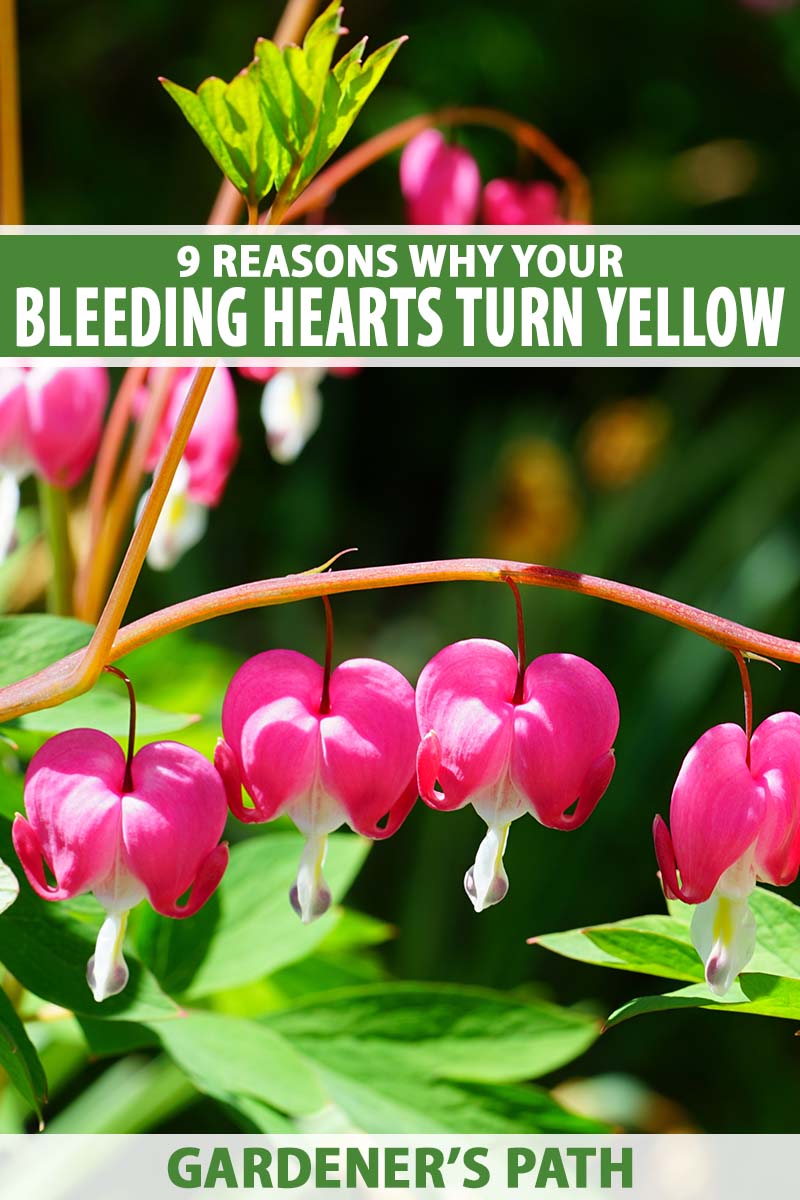
We link to vendors to help you find relevant products. If you buy from one of our links, we may earn a commission.
In the following guide, we’ll discuss the nine main reasons why your bleeding hearts may be yellowing.
Ready to solve the mystery? Read on!
What You’ll Learn
Beginning with a quick look at the different species that may be referred to by the name bleeding heart, we’ll explore common culprits that may cause their leaves to yellow, from environmental conditions to diseases and pests, physiological processes, and variety.
A Bit About Bleeding Hearts
Bleeding hearts (Lamprocapnos spectabilis) are part of the poppy family, Papaveraceae. They get their name from the unmistakable Valentine’s Day heart shape of the flowers.
Each bloom has a “droplet” coming out of the bottom portion, hence the “bleeding” part of the name. This droplet is actually the flower’s stamen!

There are a couple of interesting things to note about L. spectabilis, also called “lyre flowers,” as their shape strongly resembles that of the instrument, and “lady’s locket.”
First, they are pendant flowers, meaning each bloom hangs from a stem like the charms on a bracelet, or like a heart-shaped locket on a necklace. And second, L. spectabilis plants are spring ephemerals.
This means they burst forth in early spring, put all their energy into growing leaves and flowers, and then die back all at once in midsummer. Notice I said “most” varieties – we’ll come back to this in a moment – it’s significant!
One final note: many of the plants found in nurseries and grown in gardens are Asian bleeding hearts, L. spectabilis, which are native to northern China, Korea, and Japan.
Until 2006, the Royal Horticultural Society considered this species to belong to the Dicentra genus, which counts the fringed, D. eximia, and the Pacific bleeding heart, D. formosa, among its members.
Its old name and a common synonym that you will still see today is Dicentra spectabilis. You can read more about the name change in our guide to growing bleeding hearts.
With both D. eximia and D. formosa, the heart shape of the flower is less pronounced than it is in L. spectabilis varieties.
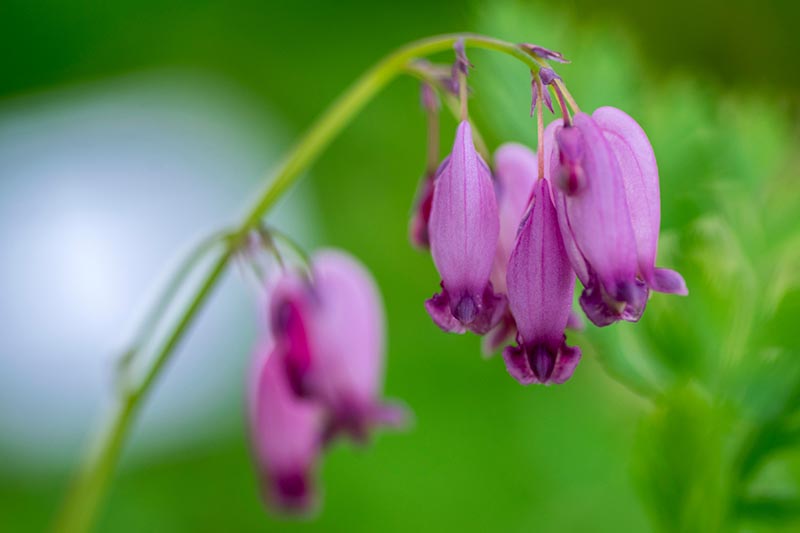
And while L. spectabilis grows up to about three feet tall and wide, D. eximia and D. formosa are both a bit more compact, growing one to two feet tall and up to three feet wide.
Plus, the fringed bleeding heart is native to an area ranging from Pennsylvania and West Virginia down through Tennessee and North Carolina, but has naturalized in much of the southeastern and northeastern parts of the United States.
The Pacific type, true to its name, is native to the moist, wooded regions of the Pacific Northwest.
But the biggest difference between the Lamprocapnos and Dicentra species is that D. eximia and D. formosa are not spring ephemerals.
Like L. spectabilis, these Dicentra species are suited to Zones 3 through 9. Their bloom time, however, extends from early spring all the way until the first frost.
When we talk about bleeding hearts, we’re largely referencing the Asian species and not the wild, less showy fringed and Pacific types, but all three may be referred to by the same common name.
And aside from the “old age” reason for yellowing leaves, many of these reasons may also apply to those in the Dicentra genus.
The Top 9 Reasons Your Bleeding Hearts Are Turning Yellow
Let’s dig into the reasons why this unusual flower’s leaves may be turning yellow.
1. Too Much Heat
Maybe you brought home a plant from the nursery and eagerly put it in your bright, sunny front yard, figuring it would probably get enough shade because you see some shade in that area every day.
But instead, the delicate green leaves begin to turn yellow after just a day or two. If this is the case, take a good hard look at the planting location and the temperature.
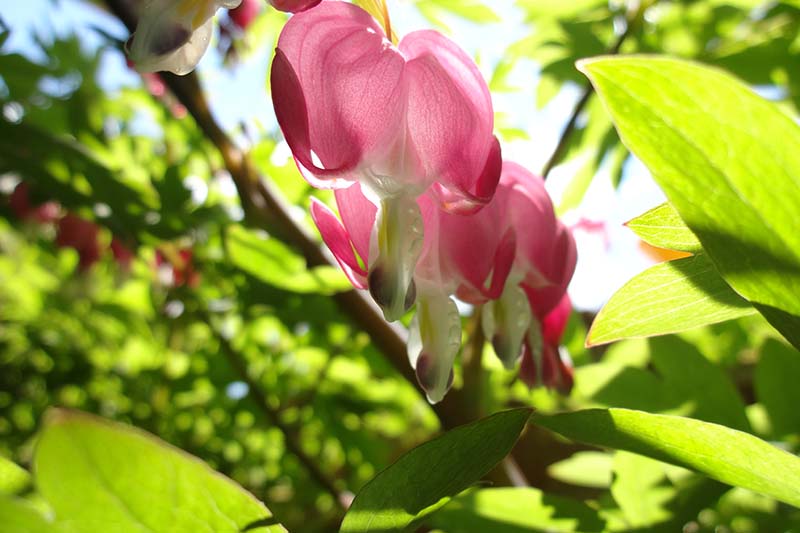
While the ideal regions for growing these heart-shaped beauties span Zones 3 through 9, Zone 9 is a lot warmer than Zone 3 for a good part of the year. L. spectabilis is happiest when the temperature is between 55 and 75°F.
The average high temperature in April for Orlando, Florida in Zone 9 is around 82°F. Compare this to Bemidji, Minnesota, which is in Zone 3 and has an average temperature of just 50°F in April.
The plant will naturally bloom a little later in Bemidji than it would in Orlando, but it’ll last longer in the cooler temperatures, too.
Of course, you can still grow it in hotter areas at the higher end of its acceptable range, and as long as it’s in full shade – which may feel 10 to 15 degrees cooler than a spot in direct sunlight – and has appropriate moisture, it’ll do fine.
But if it’s not in full shade, the heat and intense sunlight might serve as a signal to the plant to die back and go dormant prematurely, hence the yellowing leaves.
As a rule of thumb, follow this advice for whichever type of bleeding heart you plant:
- Partial shade in Zones 3 through 6
- Full shade in Zones 7 through 9
This will help to keep your plant healthy, happy, and green.
2. Too Little Water
If your bleeding hearts don’t receive enough water, they aren’t able to take up the nutrients they need, which results in wilting and yellowing leaves.
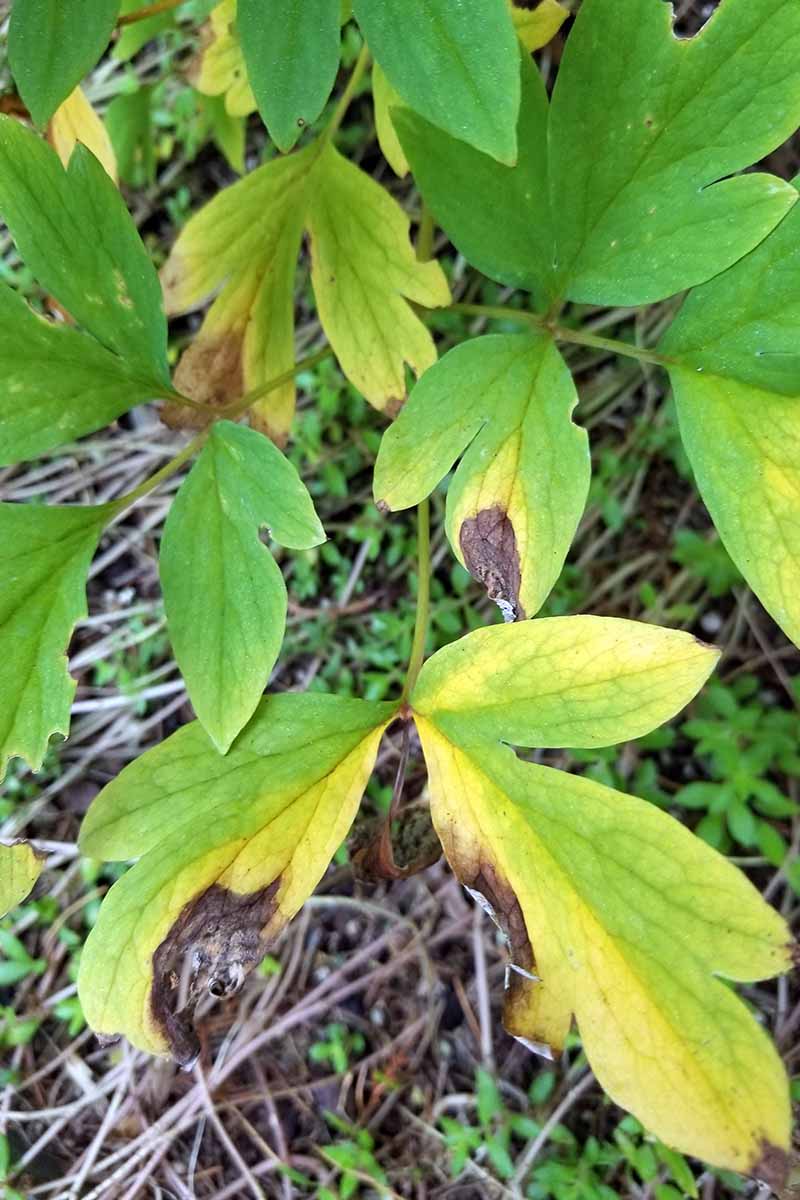
Keeping your plant well watered is especially crucial in hot, dry weather. Make sure you check the soil every couple of days with your finger or a soil moisture meter, ensuring that it’s moist one inch down.
If you let it dry out, the newest leaves will start turning yellow and you’ll need to provide some extra TLC to bring it back to good health. The first thing you should do is give it a long, deep watering.
Check the soil moisture every day and administer another deep watering as soon as it feels dry.
Remember, they love cool, shady, evenly moist conditions. Try to mimic this as much as you can, and your plants will thank you.
3. Too Much Water
Just as too little water can cause leaves to turn yellow, so can too much water. Overwatering your bleeding hearts makes it difficult for the roots to receive adequate oxygen and can lead to root rot and fungal diseases.

That’s why it’s important to check your soil every day or two, and if it still feels wet one inch down, hold off on the water until the soil feels dry to that depth.
Don’t forget to keep checking the soil every couple of days, though, because you don’t want it to stay dry for much longer than a day.
If it’s been raining a lot in your area, you may want to help aerate the root system – which is shallow and spread out – by poking between five and seven holes in the soil.
Use a screwdriver to do this, and insert it into the dirt slowly to make sure you don’t disturb the root system. If the screwdriver bumps up against a root, move it around until it goes down easily.
4. High Soil pH
It’s tempting to skip the soil test at planting time, but if you notice that it’s early spring, your plant is growing in the shade, and the leaves are still turning yellow prematurely, it’s a good idea to conduct a soil test.
They shouldn’t turn yellow from age until mid-July or August, depending on your growing zone.
The ideal soil pH for bleeding hearts is 6.0 to 7.0. They’ll tolerate pH levels between up to 7.5, but once you hit about 7.6 the alkalinity may start to cause problems.
As with many other plants, bleeding hearts need appropriate amounts of iron, manganese, and zinc in order to form chlorophyll, which is the pigment that makes leaves green.
Each of these nutrients becomes less available to these plants as the soil pH climbs, resulting in a lack of chlorophyll and the ensuing leaf yellowing, or chlorosis, according to Brian Hudelson, Ph.D., Director of Diagnostic Services at the University of Wisconsin-Madison Extension.
If your soil test determines that the pH is too high, make it more acidic by amending with sulfur according to the package instructions.
But if the soil pH is between 6.0 and 7.0, or even up to 7.5, and you discover via testing that there’s an iron, magnesium, and/or zinc deficiency instead, foliar applications of these minerals can help in the short-term.
For an all-in-one concentrate, try SaferGro Biomin Starter, a complex micronutrient concentrate that supplies essential nutrients – including iron, magnesium, and zinc – to your plants.
You’ll mix one tablespoon of the concentrate with one gallon of water in a spray bottle.
Apply it to the leaves for a quick fix, and to the soil for a longer-term solution, repeating about every three to four weeks throughout the growing season or until you no longer notice that the leaves fade between applications.
SaferGro Biomin Starter is available from Arbico Organics.
5. Fusarium Wilt
If you notice that the leaves are turning yellow, twisting, and wilting just on one side of your plant, you might be dealing with fusarium wilt.
This disease is caused by the soilborne fungus Fusarium oxysporum, which “infects the vascular or water-conducting tissues of plants,” according to the Connecticut Agricultural Experiment Station’s Plant Pest Handbook entry on bleeding hearts, edited by Dr. Sharon M. Douglas and Dr. Richard S. Cowles.
With its moisture uptake restricted, an infected plant will begin to show symptoms of drought even if you’re watering it consistently.
Fusarium wilt tends to plague plants in warmer growing zones, as it does not thrive in temperatures below about 68°F. It is most active at soil and air temperatures between 75 and 80°F.
Unfortunately, there’s no effective treatment available for fusarium wilt.
To help determine that what you’re looking at is in fact this disease, carefully open an affected stem by prying it apart with your fingers or with a sharp gardening knife.
It will most likely look rotted and brown inside. If it doesn’t, you may not be dealing with fusarium wilt at all, but with one of the other issues we mention instead!
If it does have a fusarium infection, pull the affected plant.
Burn the diseased plant or dispose of it properly as is appropriate in your neighborhood so that it can’t infect your other bleeding hearts or the highly susceptible veggies you might be growing in your garden, such as tomatoes, peppers, eggplants, and sweet potatoes.
Since it’s a soilborne pathogen, F. oxysporum may have also infected other plants growing nearby.
Your best bet is to remove as much of the diseased plant as you can, including the roots, and apply a fungicide that targets F. oxysporum to the affected soil, as well as the soil growing beneath the surrounding plants.
Actinovate AG is a biological fungicide that contains the microbe Streptomyces lydicus, which works by colonizing the soil and displacing the pathogenic fungi.
Pick up a bag at Arbico Organics if you need it.
6. Verticillium Wilt
If your leaves wilt when they’re still green, with yellowing to follow, you might be dealing with the relatively rare but serious disease known as verticillium wilt, which is mainly caused by the soilborne fungi Verticillium dahliae and V. albo-atrum.
Wilting of the leaves is the first sign of infection. After they wilt, the leaves turn yellow, and then brown.
If you notice that green leaves are wilting and your plant is consistently moist, meaning that underwatering isn’t the reason for wilting, that’s a big warning sign that something is wrong.
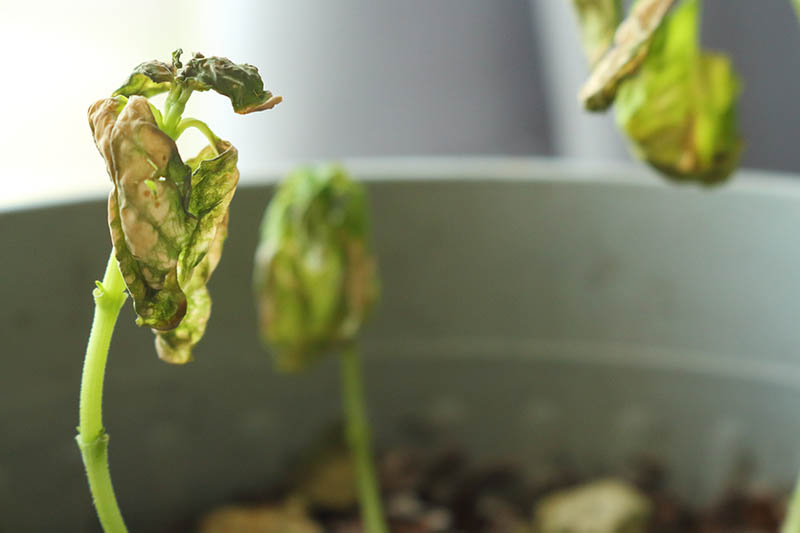
Unfortunately, once verticillium wilt hits your plant, there’s nothing you can do to save it. Pull it up and clear all plant debris from the soil.
Treat the soil and surrounding lyre flowers with a biological fungicide like Actinovate AG, and refrain from planting bleeding hearts, peonies, delphiniums, and any other plants that are susceptible to verticillium wilt in that area for at least three years.
To help prevent verticillium wilt, keep your bleeding hearts as cool as possible if you live in a hot, dry climate, and make sure you water them consistently.
Vigoro Bold Blooms Flowering Plant Food
Keep them well fertilized by applying a 15-30-15 NPK fertilizer – like Vigoro Bold Blooms Flowering Plant Food, available from the Home Depot – every six to eight weeks according to package instructions.
The happier and healthier you keep them, the more resistant they’ll be to harmful diseases like verticillium wilt!
7. Aphids
The severity of an aphid infestation can vary depending on how many of the little insects have discovered your plant. But if you see just a few aphids on your bleeding hearts, don’t ignore them!
Spray them off with the hose and watch your plant closely for a few days. If they come back in droves, it’s time to act, because here’s the thing: aphids suck the sap out of plants, which can result in weakened, yellowing leaves.
To get rid of aphids, spray your entire plant with neem oil spray, like this one from Bonide, available at the Home Depot.
Reapply once every one to two weeks – once a week if you keep seeing aphids, or once every two weeks if you don’t but want to make sure they don’t come back.
Check out our guide to controlling aphids for more information.
8. Old Age
Those of you who plant Asian types will notice that the leaves begin to turn yellow sometime between early July and mid-August, depending on where you live. This is perfectly normal for a spring ephemeral!
Non-Asian types will also die back in the fall after the first frost hits.
The leaves will turn yellow and then brown, with the entire plant dying back and going dormant until springtime returns.
Once the foliage is all brown and dead-looking, cut it back to two inches above the ground. Don’t worry, the foliage is dead but the roots and crowns are still alive – just dormant!
It’s important to allow it to turn brown so that the leaves can draw in the energy the plant will need when it awakens from dormancy.
Mark the location with a t-label, like these from Vigoro that are available from the Home Depot, so you don’t accidentally plant over them.
You’ll see your lovely bleeding hearts again before too long.
9. You Planted a Yellow Variety
The final most common reason why your leaves might come in big, beautiful, and…yellow? They’re a golden variety that’s meant to have yellow leaves!

Sometimes, we don’t necessarily look too closely or know the specific variety of something we plant, especially if a friend gave it to us.
If this is the case with you and your plant develops golden leaves in late winter or early spring instead of green ones, check the variety you purchased.
You may need to call the nursery or friend you received it from to confirm the details of its identity!
Or, compare photos with the varieties ‘Gold Heart,’ the most well-known yellow-leaved type, or ‘White Gold,’ which is very similar in appearance to ‘Gold Heart,’ but with white flowers instead of pink ones.
If the plant appears healthy and is producing new yellow foliage and plenty of flowers, you may just have a yellow-leaved variety on your hands.
Stay Gold (Or Not)
As you can see, some of the reasons why your bleeding hearts are turning yellow are good, and normal. Others, not so much.
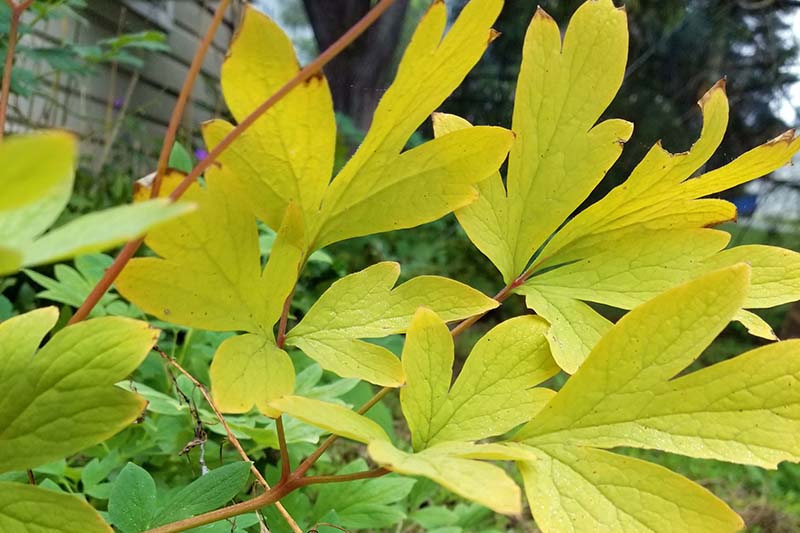
Have you ever been unpleasantly – or pleasantly – surprised by yellow leaves on your bleeding hearts? We’d love to hear your stories and questions in the comments below.
And for more tips on caring for bleeding heart plants, don’t miss these articles:
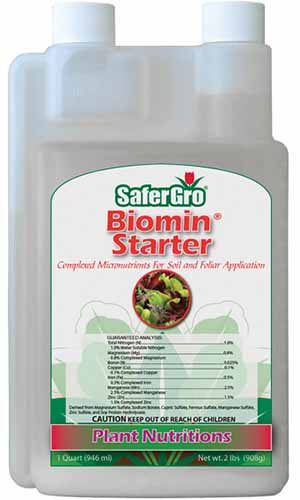
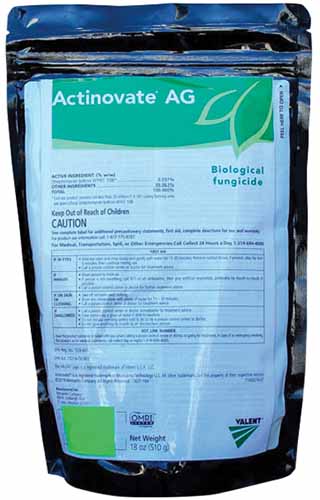
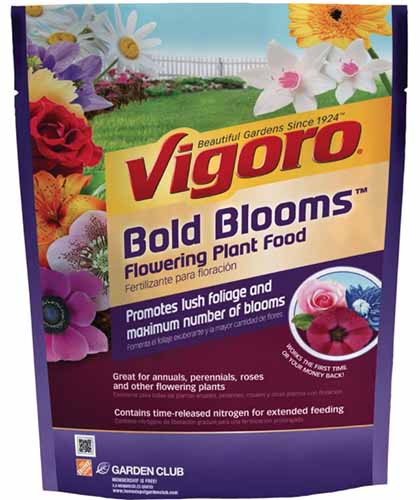
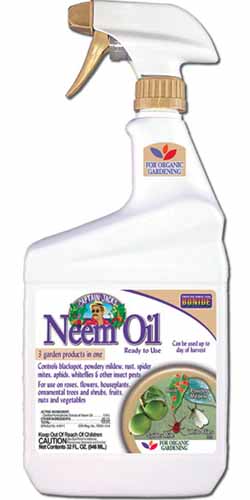

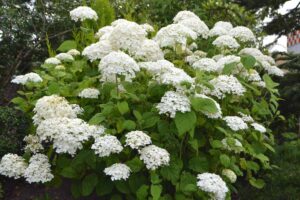
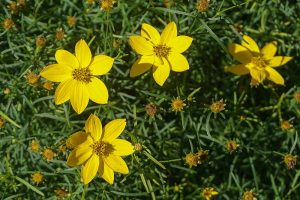

This was extremely helpful! Thank you! And now I have some hope that my formerly gorgeous (now yellow) bleeding heart is just aging and not being slowly murdered by me
You’re welcome! Spring-time ephemerals die back with the onset of summer- it’s just a part of the life cycle at this time of year, not to worry!